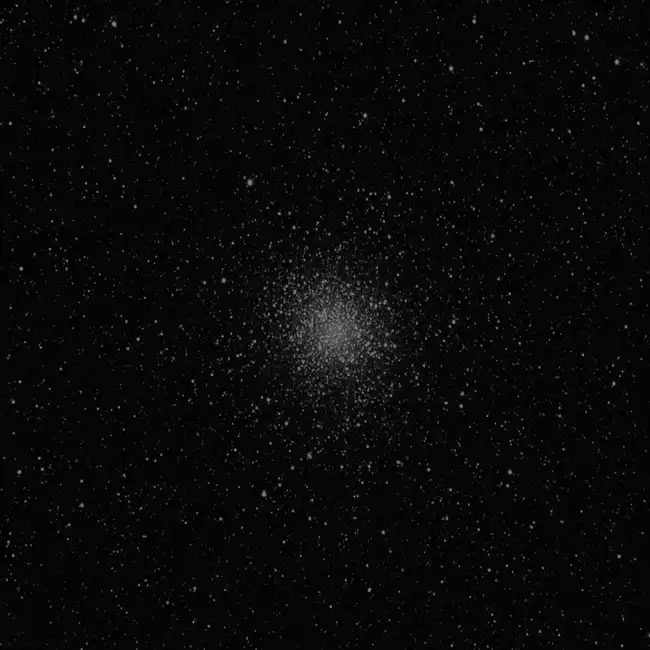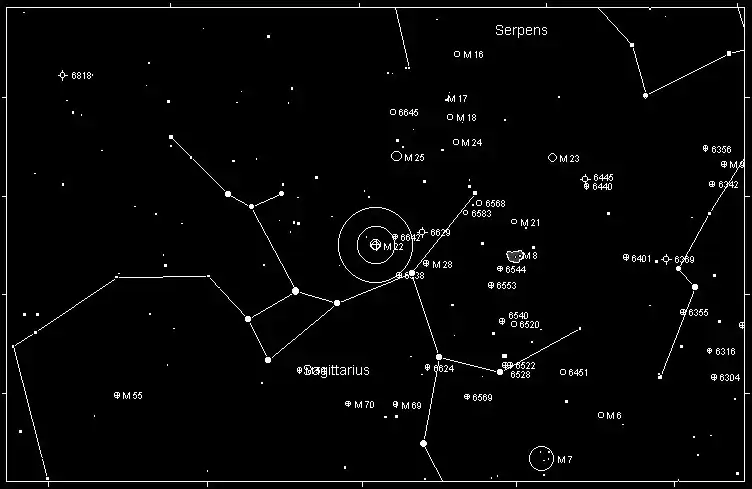Messier 22, also known as M22 or NGC 6656, is a remarkable globular cluster situated in the constellation Sagittarius. Globular clusters are densely packed groups of stars that orbit the Milky Way’s halo, and M22 is one of the most magnificent examples. Containing over 100,000 stars, this cluster lies approximately 10,600 light-years away from Earth and spans about 97 light-years in diameter. Its compact nature and high concentration of stars give M22 a stunning appearance when viewed through telescopes.
M22 is particularly notable because it is one of the closest globular clusters to Earth, making it one of the brighter globular clusters in the sky. In fact, it is the third-brightest globular cluster visible from northern latitudes. With its densely packed stars, two planetary nebulae, and the potential for a central black hole, M22 offers much to astronomers and stargazers alike.
Magnitude
Messier 22 has an apparent magnitude of +5.1, which means it is bright enough to be seen with the naked eye under very dark skies, though binoculars or a telescope are usually recommended for clearer viewing. Its brightness and proximity make it a popular target for amateur astronomers, particularly during the summer months when it is most prominent in the night sky.

Season and Prominence
M22 is best observed during the summer months, particularly from late June to August. During this time, it is high in the sky during the evening hours, providing an excellent opportunity for stargazers to observe it. Its location near the center of the Milky Way galaxy means that it is often seen against a rich background of stars, enhancing its visual appeal.
Observers in the Northern Hemisphere will find M22 rising in the southeast after sunset and reaching its highest point around midnight. It is also visible in the Southern Hemisphere, where it appears higher in the sky.
Constellation
Messier 22 is located in the constellation Sagittarius, also known as "The Archer." Sagittarius is a prominent summer constellation and is easily recognizable due to its characteristic “teapot” asterism. M22 is situated just above the spout of the teapot, making it relatively easy to locate once you've found the constellation.
How to Find M22
To locate Messier 22, start by finding the Sagittarius constellation. The teapot asterism within Sagittarius is an excellent guide. The spout of the teapot points toward the center of the Milky Way, and M22 lies just to the northeast of the spout, near the star Lambda Sagittarii.
For binocular observers, M22 will appear as a faint, fuzzy patch of light. A small telescope will resolve the cluster into a dense, grainy ball of stars, while larger telescopes will reveal individual stars in the cluster's outer regions. Under high magnification, the core of M22 can appear like a swarm of bees, with countless stars tightly packed together.

History
Messier 22 was discovered by the German astronomer Abraham Ihle in 1665, making it one of the earliest known globular clusters. Charles Messier added it to his famous catalog of celestial objects in 1764. Although Messier mistakenly believed the cluster was a nebula without stars, subsequent observations with more powerful telescopes revealed its true nature as a globular cluster.
Throughout the 20th century, M22 continued to intrigue astronomers. In 1986, two planetary nebulae were discovered within the cluster, making it one of only a few globular clusters known to contain such objects. More recently, astronomers have speculated about the existence of a central black hole within M22, although this remains a subject of ongoing study.
Conclusion
Messier 22 is a captivating object in the night sky, offering amateur and professional astronomers alike the chance to observe one of the brightest and closest globular clusters to Earth. Nestled in the rich constellation of Sagittarius, this ancient cluster provides a glimpse into the early history of our galaxy. Whether you’re gazing at it with binoculars or resolving its individual stars with a telescope, M22 is a must-see target for any stargazer during the summer season.
